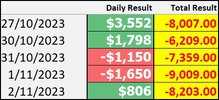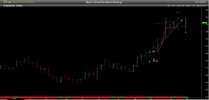- Joined
- 3 May 2019
- Posts
- 6,349
- Reactions
- 10,041
I'm guessing that the cell fill and font colour for the total column changes if it gets into the black?Updated cell format
I'm guessing that the cell fill and font colour for the total column changes if it gets into the black?Updated cell format
I'm guessing that the cell fill and font colour for the total column changes if it gets into the black?
Don't entirely agree with this. One of the major benefits of trading the weekly charts is to remove ourselves from the day to day volatility and the associated emotional ups and downs.
However, I agree that a huge daily down bar in a stock maybe an early exit signal and may save a few dollars while waiting to the EOW exit signal.
Mr Skate,
I'm with Peter on this one.
A weekly strategy (should) be a weekly strategy. That's what was tested, that's the rules. If not, then it's not a mechanical system, it's a discretionary system masquerading as a mechanical system. It might even be more dangerous than that as our trader clearly is in breach of any form of discipline whatsoever and clearly is trading on emotion alone.
Now I accept that this is a paper trading exercise. However, a paper trading exercise is to test under realistic conditions, the already tested/accepted system. Otherwise what are you doing? Developing a strategy on the fly?
The whole point of a mechanical system are that the rules are set: are inviolate: and are followed.
jog on
duc
Seems to me you are you arguing with an Academic
I could be wrong ?
NB; Captain Peter the 2nd is not an ACADEMIC !@Captain_Chaza, I deeply respect the insightful contributions from @ducati916 and @peter2. Their unique experiences provide a wealth of knowledge that is truly invaluable. Their contributions to the discussion are greatly appreciated, and their experience and expertise are evident in the information they provide.
It's important to recognise that everyone brings unique perspectives and experiences to the table, and it's crucial to learn from one another. I may not have the same level of experience as these members, but I'm eager to learn from their experiences and apply their insights to my own understanding.
Skate.
it's a full on bear market




@Skate if I can use the analogy of a band, the trend is the lead singer of the band but without the other instruments to provide the music, the song is not always a success. So what I'm trying to say is, long-term or short-term, you still need all the elements together that give you a high probability of success. The difference between short-term and long-term is mainly the time frame, but sometimes a short-term trade can turn into a long-term trade. I'm not sure if this is feedback that you were looking for but I just thought that I'd throw it out there.Thinking out loud
I've been thinking about how to improve and code a simple trading strategy, and I've come up with an idea that I'd like to share.
Currently, my initial idea uses a trend-following buy condition that checks if the security is in an uptrend. This works well for capturing long-term trends, but I'd like to also capture short-term trends. To do this, I'm considering adding two momentum-based conditions to check if the security's price exhibits strong upward momentum.
By combining these three conditions, I believe I can create a strategy that captures both short-term and long-term trends. The trend-following condition would help me identify the overall direction of the market, while the momentum-based conditions would help me identify when the security's price is exhibiting strong upward momentum.
Any thoughts on this idea?
Skate.
@Skate if I can use the analogy of a band, the trend is the lead singer of the band but without the other instruments to provide the music, the song is not always a success. So what I'm trying to say is, long-term or short-term, you still need all the elements together that give you a high probability of success. The difference between short-term and long-term is mainly the time frame, but sometimes a short-term trade can turn into a long-term trade. I'm not sure if this is feedback that you were looking for but I just thought that I'd throw it out there.
I feel like I shouldn't have made my last post as it only tells a small part of the story. The thing that makes trading so hard is the number of parts that may make up your personal form of trading and the weighting you give to each part. The time that you want to stay in the trade is one part, stock selection is another, and many other macro and micro elements to mix together and bake the particular cake that is pleasing to your pallet. It's too hard for me to find the words that describe my thoughts so I'll finish up saying that I think it's important or at least worthwhile to write out a description of the type of trading that you want to do incorporating the macro elements in the description. When the final draft has been reached then the micro elements can worked out.@DaveTrade, thanks in advance for your input. My initial thought was to use a two-pronged approach, combining both trend and momentum analysis to help identify potential trading opportunities.
As a trend trader, I'm used to focusing on the bigger picture and identifying long-term trends. However, I'm aware that incorporating momentum to identify shorter-term opportunities might just help improve my trading.
I've managed to code such a strategy and backtests aren't too shabby.
Skate.
I feel like I shouldn't have made my last post as it only tells a small part of the story. The thing that makes trading so hard is the number of parts that may make up your personal form of trading and the weighting you give to each part. The time that you want to stay in the trade is one part, stock selection is another, and many other macro and micro elements to mix together and bake the particular cake that is pleasing to your pallet. It's too hard for me to find the words that describe my thoughts so I'll finish up saying that I think it's important or at least worthwhile to write out a description of the type of trading that you want to do incorporating the macro elements in the description. When the final draft has been reached then the micro elements can worked out.

With the safety of new traders in mind, in my opinion this approach would only work in a trending market. If the market was not trending your win/loss ratio could skew sharply towards the loss side and therefore causing your account balance to decline.Very interesting point above about the complexity of trading for success. The most success I've had ever full time trading was simply having a sell rule. If a stock went down 5%, I sold. If it went up 10%, I sold. You could literally throw darts at the RIH dart board and win. Not sure why I'm not doing that now. I might revert to the old system next year when I inevitably fail at attempted value investing.
One might suggest, easy come and extremely easy gone.With the safety of new traders in mind, in my opinion this approach would only work in a trending market. If the market was not trending your win/loss ratio could skew sharply towards the loss side and therefore causing your account balance to decline.
Hello and welcome to Aussie Stock Forums!
To gain full access you must register. Registration is free and takes only a few seconds to complete.
Already a member? Log in here.